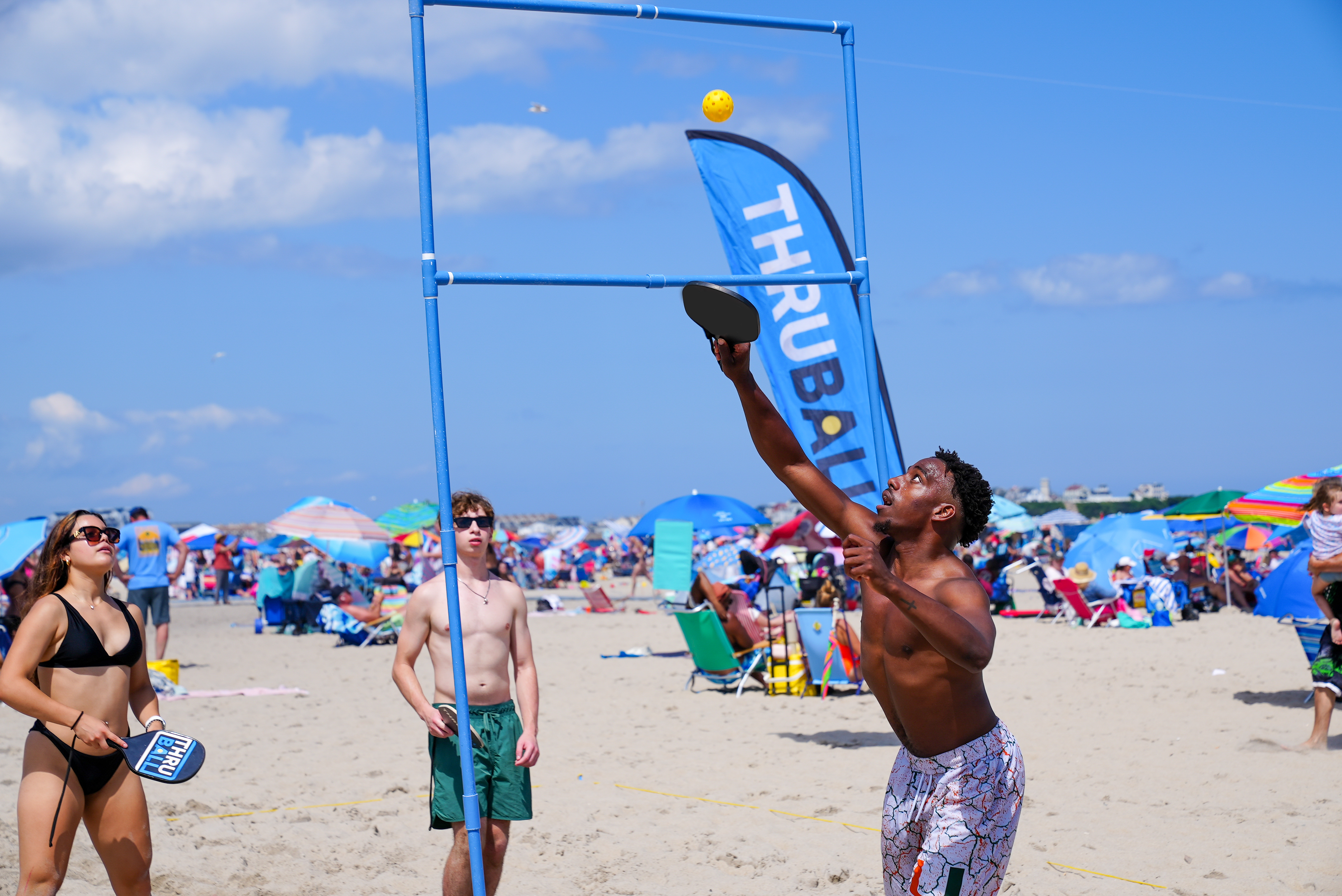HOW TO SET UP

HOW TO PLAY
Thruball is a team sport played by two teams, each consisting of two players. Each team lines up on opposing sides of the court with the gate in the center of the boundary lines.
A point begins when the server hits the ball through the gate towards the opposing team. The object of the game is to hit the ball through the gate in such a way that the opposing team cannot successfully return it. Each team is allowed up to three touches, but no less than two touches to return the ball through the gate. The rally continues until a team is unable to return the ball through the gate.
Thruball is a self-officiated sport where responsibility for fair play falls on the players. All players are expected to know the rules, and the integrity of Thruball depends on each player upholding them. Highly competitive play is encouraged, but never at the expense of the mutual respect among competitors or the simple joy of play.
How do you serve and keep score?
A game starts with a “rally for serve”, where no points are awarded to either team, but the team who gets to serve first is decided. Either team can start the “rally for serve”.
Basic Thruball rules follow a “gentleman’s serve” approach, where the ball is served through the gate with the sole intent of getting the point started.
In Thruball, a point can only be scored by the serving team. If the rally is lost by the serving team, no points are awarded, but the serve switches to the receiving team for the next rally. If a point is won by the serving team, the serving player continues to serve until the receiving team wins a rally.
Teammates must alternate who the server is each time a serve is won back from the opposing team.
A legal serve occurs when the server hits the ball through the gate without making contact with it, and the ball lands within the boundary lines or an opposing player makes contact.
Faults: A player serving the ball is allowed one fault, at which point the server has one more attempt to hit a legal serve. If a server hits two faults, the serve is lost and switched to the opposing team. Examples of faults are as follows:
If a serve lands outside the boundary lines.
If a serve misses the gate.
If a serve makes contact with the gate without going through.
Lets: A player serving the ball is allowed unlimited lets. If a player hits the ball through the gate, but the ball makes contact with the gate and lands within the boundary lines, that is a let. This requires a re-serve.
How do you play the ball?
Two hits are required at minimum by each team.
Up to three hits are allowed by each team.
Players may move as they wish during a point, but must never make contact with the stand or interfere with a player on the opposing team.
The "Kitchen" is the square area outlined by the feet of the gate between the two legs. Players may enter the "Kitchen" area to retrieve, set, or hit a shot in an upward trajectory through the gate; however, landing in the area while hitting a spike shot through the gate is prohibited.
A legal hit is anything that makes contact with the paddle only.
A player’s body may never make contact with the ball.
A player may not make contact with the ball twice consecutively, unless the ball ricochets off the gate on their team’s second hit. If the ball ricochets off the gate on the team’s second hit, either team member may use their team’s third hit to get the ball through the gate.
Double contact (the paddle making contact with the ball twice in one hit) is not allowed, and results in a loss of serve or point.
Other Ways to Play
Non-Gentleman’s Serve: Serving with the intention of scoring a point. Serve must be done with the player’s back foot on the boundary line.
Longest Volley: Using this method, all 4 players are on the same team, and each pass through the gate counts as 1. The goal is to reach the highest number possible as a group.
Have more questions?
We've got you covered
Common Q&A:
HOW DO YOU SCORE?
Each team gets 2 to 3 touches to return the ball to the opposite team. Think, pop, set, smash!
Points can only be scored when serving.
A serve is lost, or a point is awarded, if the ball hits the ground, is not returned back through the gate, or is hit out of bounds.
HOW DO YOU WIN?
Games can be played to 11, 15, or 21.
Traditionally, a team must win by 2 points or more.
Please see full explanation of rules for additional information.
HOW MANY PEOPLE CAN PLAY?
Thruball is typically played with four players (2 v 2). However, with additional paddles, players can easily engage in 3 v 3 or 4 v 4 games as well! Additional paddles can be purchased here: Extra Thruball Paddles
HOW TO EXPLAIN THRUBALL TO A BEGINNER
Here's our comprehensive and concise guide for new Thruball players. Dive into the action and have a blast!
- Ready, set, FUN! When you're playing with someone for the first time, don't worry if it feels a bit tricky in the beginning. We've all been there! A little patience and practice are key. Within minutes you'll be serving, volleying, and smashing like a pro!
- Dive in, rule by rule! Forget points for now, and focus on getting comfortable with the game. Familiarize yourself with the rules, master serving through the gate, and hone the 2 v 2 gameplay. For now, let's just have some epic fun and you can focus on keeping score later!
- Power can wait, precision comes first! Hold off on those big smashes for a moment. We've got plenty of time to showcase your strength. Instead, channel your inner ninja and focus on nailing accurate shots.
- Set it up like a boss! When you're setting up the perfect shot for your teammate, think strategically. For the perfect set up for your partner, hit lofty sets within bounds, guiding your teammate closer to the gate - right where they need to be for the ultimate smash. Teamwork makes the dream work!
With these pro-tips, you'll be ruling the Thruball court in no time. Get ready to create unforgettable memories with your crew! Let's Thruball, baby!
CAN YOU TOUCH THE GATE?
You cannot touch the gate with your hands or the paddles. However, if the ball hits the gate, it can be played.
Please see the full description of the rules for more information.
CAN I USE MY OWN PADDLES AND/OR BALLS?
Of course!


